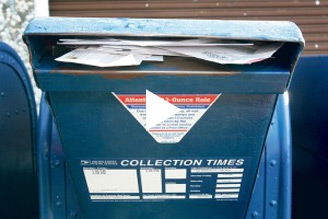Over the last decade the U.S. Postal Service (USPS) has found it increasingly difficult to keep its head above water financially, often posting annual losses in the billions. A steep decline of mail volume due to the rise of online communications has reduced USPS’s role in the market place. As the Postal Service’s fiscal instability has grown, so have calls for USPS reform. Potential reforms range from shifting to centralized delivery, changes in governance, and full privatization.
While a solution to the myriad of issues facing the Postal Service is still unsettled, what is abundantly clear is the drastic need for reforms to improve USPS financially and operationally. Below are five issues facing USPS, which highlight the need for reform.
- Mail volume has plunged 40 percent since 2001. The demise of the traditional mail system and rise of online efficiency is yet another example of government’s inability to keep up with the market. The 40% drop in mail volume since 2001 can be attributed to the rise of email, social media sites such as Facebook and Twitter, and online bill pay. All of these options provide both convenient and cost effective services that allow for more simplicity and choicer solutions.
- Junk mail accounts for 60 percent of current mail volume. In a recent bulletin published by the CATO institute, Chris Edwards, Director of Tax Policy Studies, reported that household-to-household personal letters make up a mere 3 percent of total mail volume today. Advertising (i.e. “junk mail”) on the other hand now represents 60 percent of the entire household mail volume. Bills and other business statements are the second largest type of mail, but are quickly being replaced by electronic payments, which now account for 63 percent of all bill payments.
- Over 4,000 Post Offices average fewer than 5 customers per day. It is currently the case that 4,500 rural Post Office locations average only 4.4 customers on a daily basis. In recent years USPS has looked to close a number of locations in rural areas in response to those offices barely being used, however efforts to increase efficiency and lower costs, such as ending Saturday delivery, are often blocked by Congress.
- USPS is expanding outside the core service of mail delivery. Rather than solving the already ongoing fiscal crisis, the USPS plans to expand into banking, pay day loans, and even floated the possibility of grocery delivery. Such revenue generating schemes detract from the Postal Service’s overall goal of mail delivery. USPS should instead focus on improving core services instead of expanding into others, which will likely not help with solving the problem but rather cause more financial complications.
- USPS has posted billions in annual losses for the last decade. The USPS is expert at failing to adapt to market changes and instead has consistently seen losses in the billions each year. Since 2007, the USPS has accumulated almost $60 billion in losses. Overall, the Postal Service enjoys a whopping $18 billion annually from government granted monopolies and indirect subsidies. Even with government-protected special privileges, the USPS has consecutively seen billions in losses for the past 9 years with over a billion in losses now projected for 2016.


